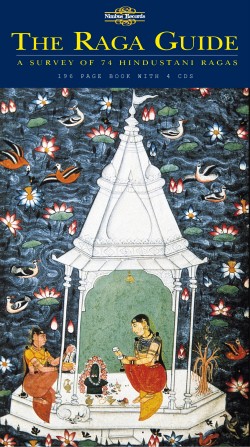![]()
![]()
![]()
![]()
The Raga Guide: A Survey of 74 Hindustani Ragas. Performed by Hariprasad Chaurasia, flute; Buddhadev DasGupta, sarod; Shruti Sadolikar-Katkar, vocal; Vidyadhar Vyas, vocal. Nimbus Records NI 5536/9. (Total time 5hrs 15min).
Note (May 1, 2003): Since Nimbus's demise, these disks have been hard to find. If you have difficulty locating them, or any of Nimbus's Indian music releases, I am told that they are available at GatewayToTheSoul.
This remarkable collection is the product of a collaboration between
traditional Indian musicans, the Rotterdam Conservatory  and
Nimbus Records. It collects 74 raga "sketches" modelled on the early recordings
of such master musicians as Abdul Karim Khan, Bundu Khan, and Dattatreya
Vishnu Paluskar. Constrained by the time limitations of the 78 rpm record,
these early 20th century artists were forced to distill their
performances into four-minute recordings. While this imposed an unnatural
constraint on the normally expansive Indian performance tradition, the
resulting records were able to transmit the essence of the raga.
and
Nimbus Records. It collects 74 raga "sketches" modelled on the early recordings
of such master musicians as Abdul Karim Khan, Bundu Khan, and Dattatreya
Vishnu Paluskar. Constrained by the time limitations of the 78 rpm record,
these early 20th century artists were forced to distill their
performances into four-minute recordings. While this imposed an unnatural
constraint on the normally expansive Indian performance tradition, the
resulting records were able to transmit the essence of the raga.
The closest analogue to the raga in Western music are the "standards" routinely used by jazz musicians as a basis for their improvisations. According to the authors of The Raga Guide:
A raga can be regarded as a tonal framework for composition and improvisation; a dynamic musical entity with a unique form, embodying a unique musical idea. As well as a fixed scale, there are features particular to each raga such as the order and hierarchy of its tones, their manner of intonation and ornamentation, their relative strength and duration, and specific approach. Where ragas have identical scales, they are differentiated by these musical characteristics.Each raga is given a three to six minute performance. The accompanying 184-page book gives a description of each raga along with transcriptions of the base scale, melodic outline and a transcription of the opening portion of each performance. Also included is a collection of ragamala paintings reproduced in full color.
While the study of this music is a lifelong pursuit (the Emperor Akbar once asked Tansen the extent of his knowledge of Hindustani music and he replied, "My knowledge is like a drop in a vast ocean of promise."), these recordings go a long way towards teaching the ear to distinguish the different flavors of the various ragas. The performances are marvellous and the varied instrumentation keeps what is really a serious, scholarly collection from sounding sterile.